I’ve backpacked the seventy-six kilometre West Coast Trail three times from Port Renfrew (south) to Pachena Bay (north) when I was fifteen, twenty-five and thirty-five years old. I did it with my family the first two times. My partner Kris was thrilled to join my parents and I for the third time. I’ve learned a lot through my three different backpacking experiences. Below are twenty-five West Coast Trail tips to help you have a successful trip. We took eight days with a rest day to backpack the first time, and seven days for both the second and third trips, with no rest day.
Table of Contents
1. West Coast Trail Tips: Six Kilometres in Six Hours
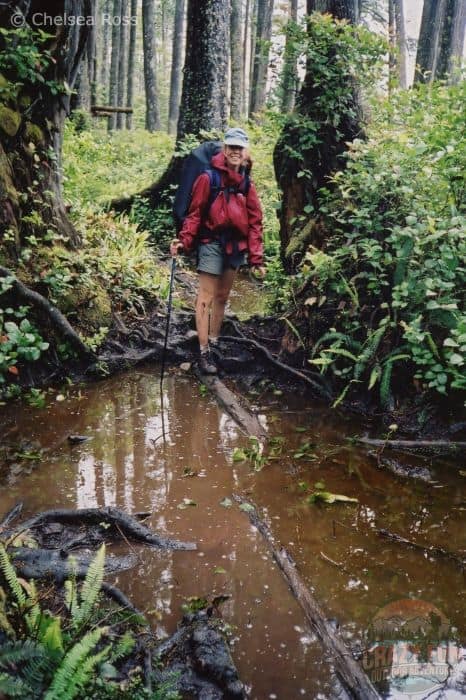
On average, people hike four kilometres an hour when backpacking. However, this isn’t the case when backpacking the West Coast Trail (on the west coast of Vancouver Island, Canada). Here, the weather tends to be wetter, surrounded by the ocean. It feels like backpacking in a rainforest when it’s been raining for days, making it an entirely different experience.
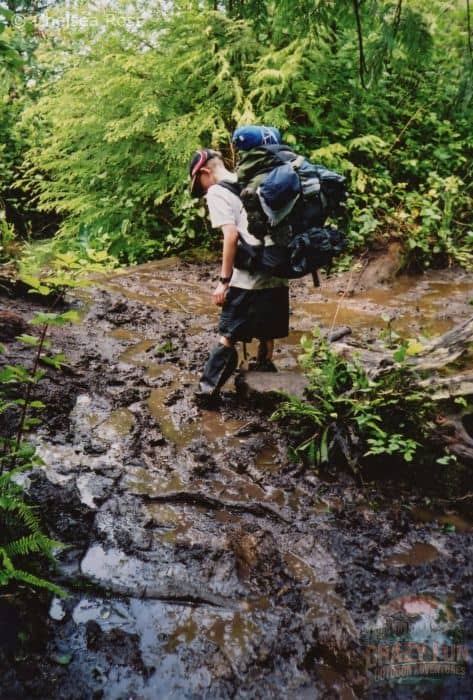
The adventure starts by crossing the south Gordon River on a boat (run by indigenous locals in the region) from Port Renfrew to the opposite bay where the trail begins. It’s about a five-minute boat ride. Starting the backpacking trip all three times, regardless of whether it was raining or not, we made it from the Port Renfrew trailhead to Thrasher Cove in six hours. One kilometre per hour. Our boots were sucked deep down into the mud up to our knees, covering our gaiters. It was a slow slog.
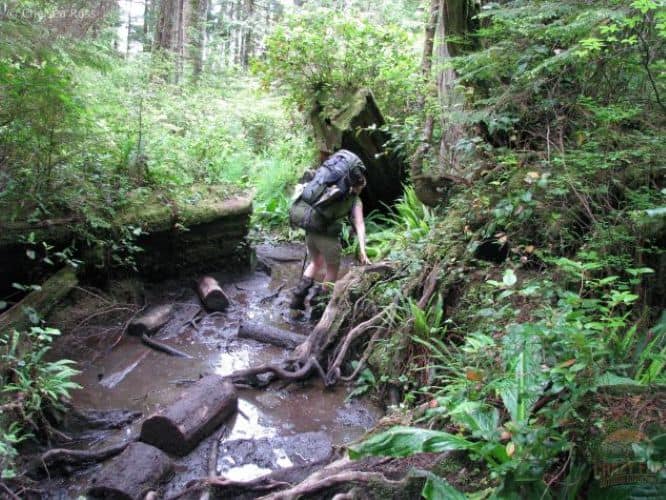
Tip: Adjust your backpacking speed according to the trail conditions and the weather. It’s sometimes not possible to go fast. Plans change moment by moment. When starting your day, it’s hard to know how the mud, ponds, and copious amounts of slippery roots in the pouring rain will affect your hiking time. Be patient and go with the flow. Take it all in! You’re on an adventure!
2. Backpacking in the Rainforest
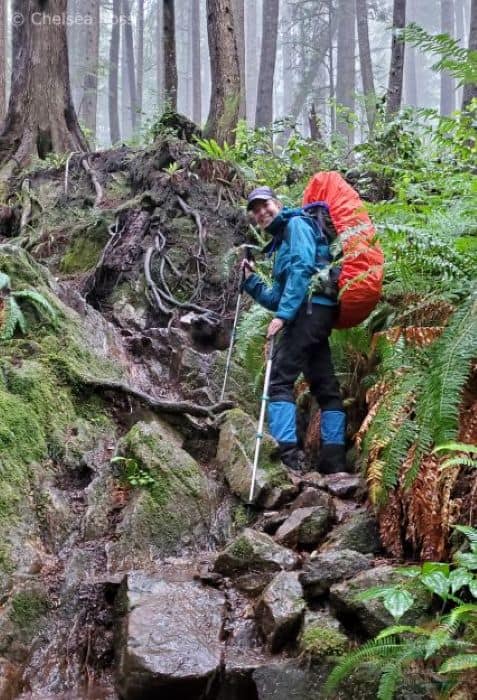
With the amount of rain they receive on the West Coast, it’s no wonder they end up with enormous plants and trees. You’ll feel like you’re backpacking in the rainforest for most of the trip.
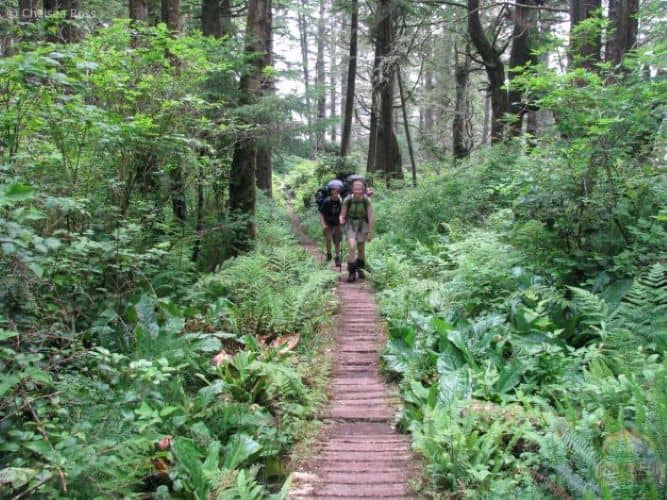
Along the way, you’ll encounter slippery boardwalks. Make sure to have your hiking poles to help stabilize you.
3. Waterproof Gear
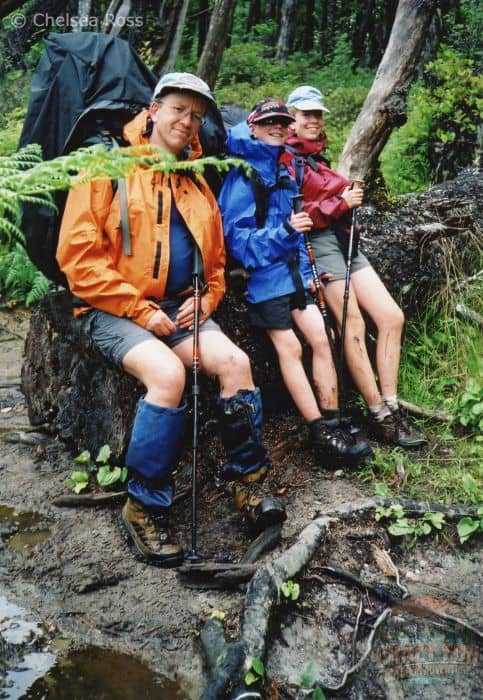
Knowing that you can experience a slow slog in the pouring rain, it’s essential to have the right gear to make it an enjoyable experience. You must use adequate rain gear to protect yourself from getting cold. Your rain jacket should have a vent (zipper beneath your armpit) to allow moisture to escape your body and create airflow. Otherwise, you’ll feel hot and uncomfortable very quickly. If you can find zippered waterproof pants, slipping them on and off over your hiking pants and hiking boots will be easier.
Waterproof gear to protect your items is crucial in my West Coast trail tips. A waterproof rain pack cover is essential to protect your belongings inside your backpack. Putting your book, journal, and camera inside a Ziploc bag is a terrific idea for added protection. Placing your sleeping bag and mattress inside a garbage bag is another wise idea. Spending money and dry sacks would also work beautifully. After feeling like a drowned rat all day, the worst thing is to unpack and find that your sleeping bag is damp too. I prefer to be extremely safe and protect the items I want to be dry. This makes for a much happier hiker at the end of the day!
4. Wildlife

The trail offers the potential to see various wildlife, especially marine animals. Sea lions can be found sunbathing on rocks protruding from the ocean.
For more animal sightings, Kayaking in Desolation Sound: 11 Tips for the Best Kayaking Trip Ever is a great option!
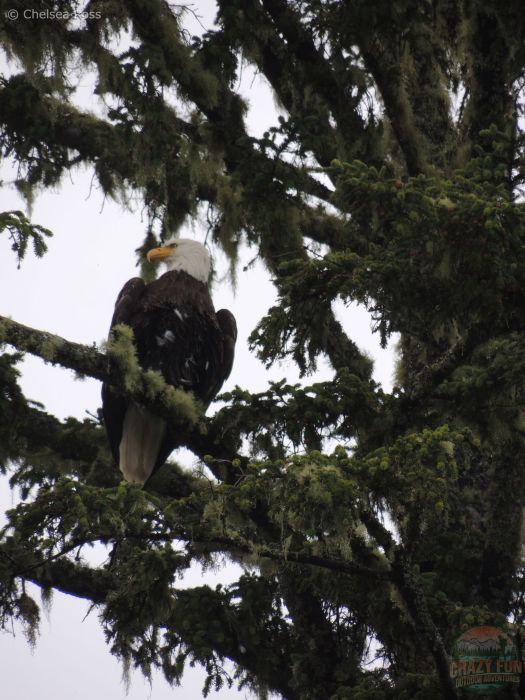
Bald eagles are often seen soaring above in the sky.

Martens can be spotted on the ground, running on rocks.
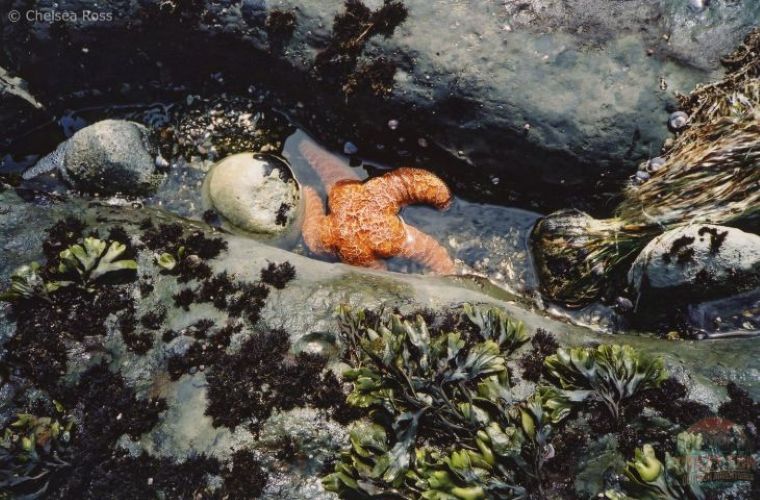
Many colourful starfish and sea anemones can be seen when walking on the ocean floor by the beach.
Tip: Pay attention to your surroundings and be on the lookout for animals!
Whale Watching
On one of our last nights while backpacking the trail a second time, we saw a whale swimming close by while making supper on the beach. It was exceptional to see, and it was a great ending to our trip! Bears and cougars can also be found, but we were fortunate not to see any!
5. Nicest Outhouses
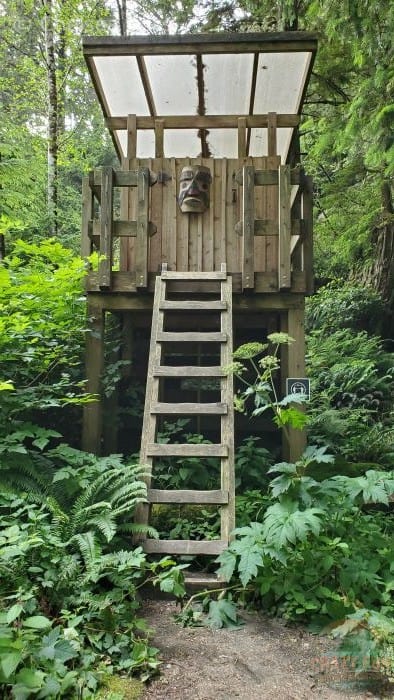
There are no flush toilets on the West Coast Trail, but these outhouses were the nicest I’ve ever seen.
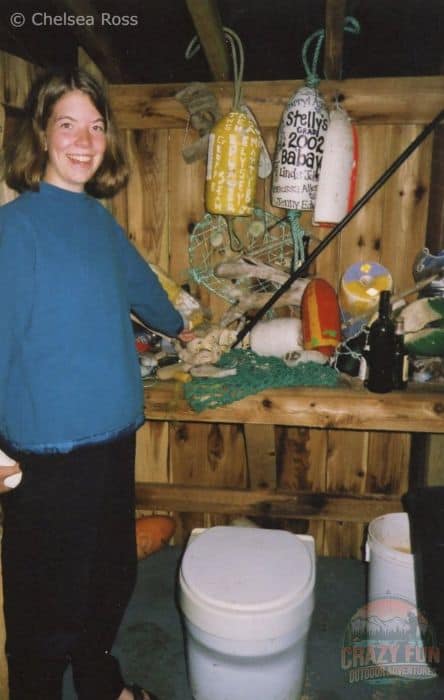
They are composting toilets, requiring you to put a scoop of wood chips in the toilet once you’ve done your business. This results in limited smells in them – a bonus! Most of them are high up, which requires you to climb up a ladder to access them, while the waste remains in the bottom half. Insects don’t usually roam in them, either.
Tip #1: Make sure to bring your own toilet paper.
Tip #2: The outhouses are further in the woods, away from the campsites and food storage, normally along a path.
Some doors have tree holes cut in them to create light when it gets dark. I appreciated their wonderful, naturalistic designs.
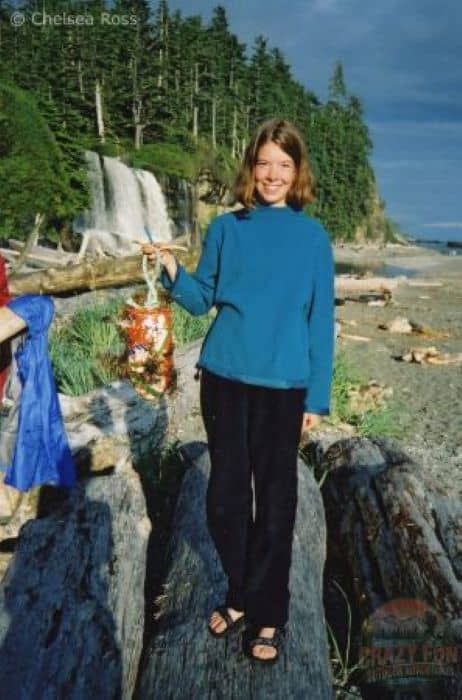
The first time I backpacked the trail, many people, including myself, created crafts with the buoys found along the shore and hung them by the bathroom to create some charming décor.
6. Tides and Timetables
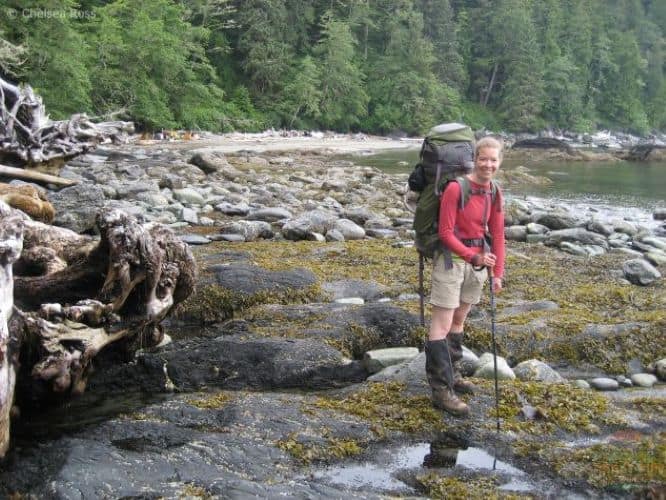
West Coast Trail Tips: Read the tide tables carefully so that you don’t get stuck on the seabed with a rising tide. This would be a scary experience, with no immediate exit to the trail in the forest. Once the tide comes in, you could end up on slippery algae, rocks, and clams that can make it difficult to walk on and maintain your stability.
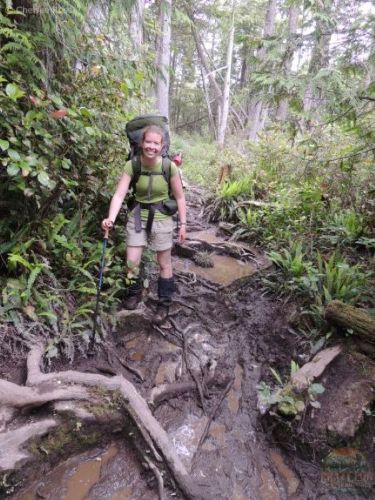
Walking high off the seabed in the forest or on the beach below is a popular way to backpack the West Coast Trail.
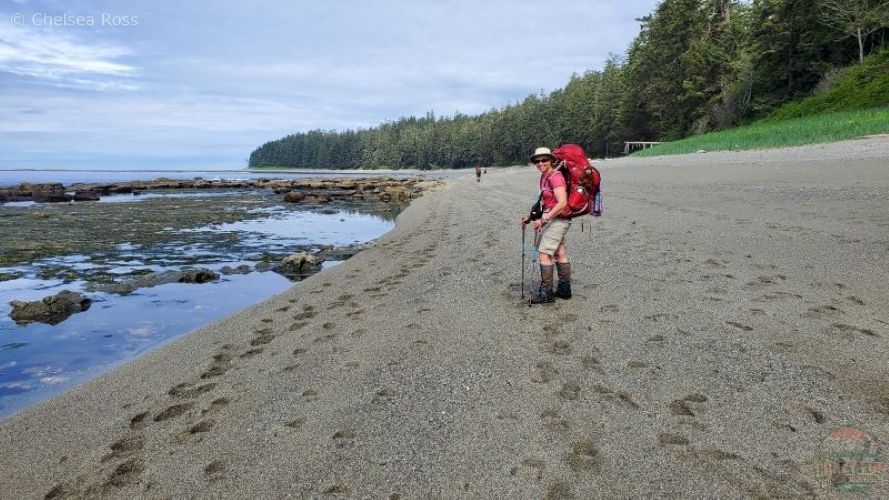
It is beautiful to hike on the beach. The incredible scenery offers many opportunities to see marine wildlife and different rock formations. It creates a nice contrast to being in the vast open space instead of surrounded by the forest all the time. Depending on where you walk, you might see old, derelict treasures on the trail.
7. Old Derelict Treasures on the Trail
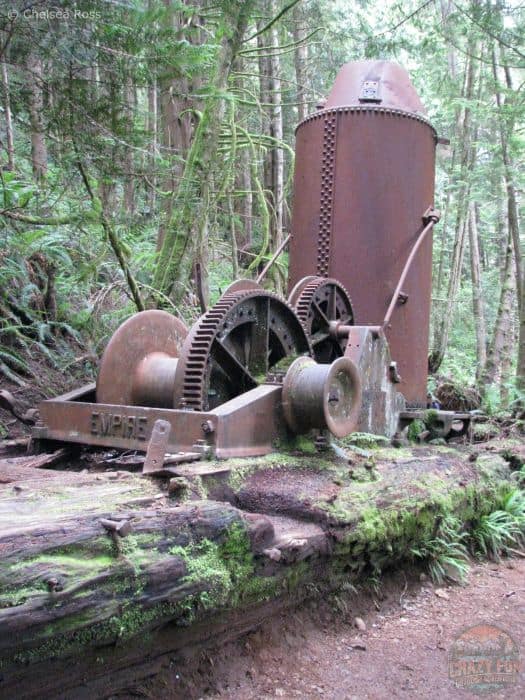
If you love history, you’ll love finding treasures in the woods or along the beach. Walking along the trail in the woods, you’ll come across old donkey engines.
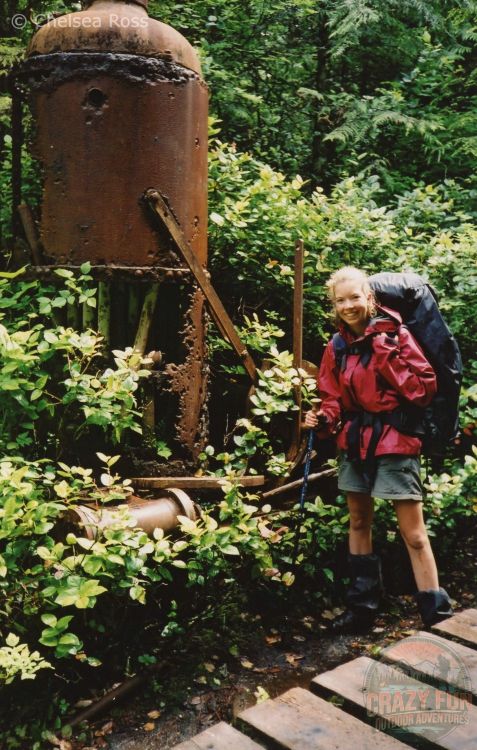
We found another old donkey engine later while backpacking.
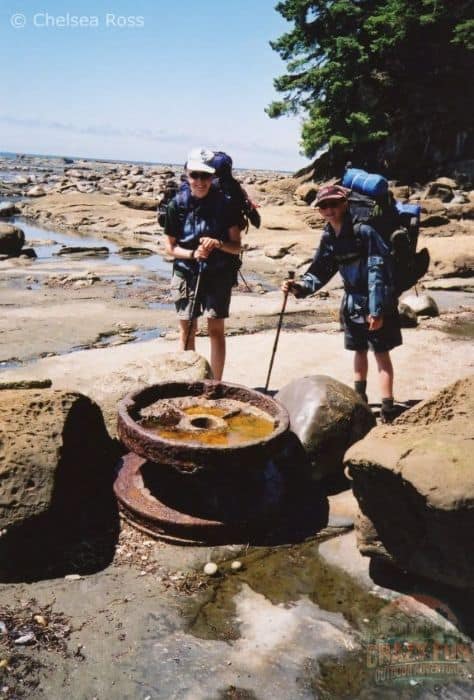
My brother and I are standing by an old, rusted wheel found on the beach.
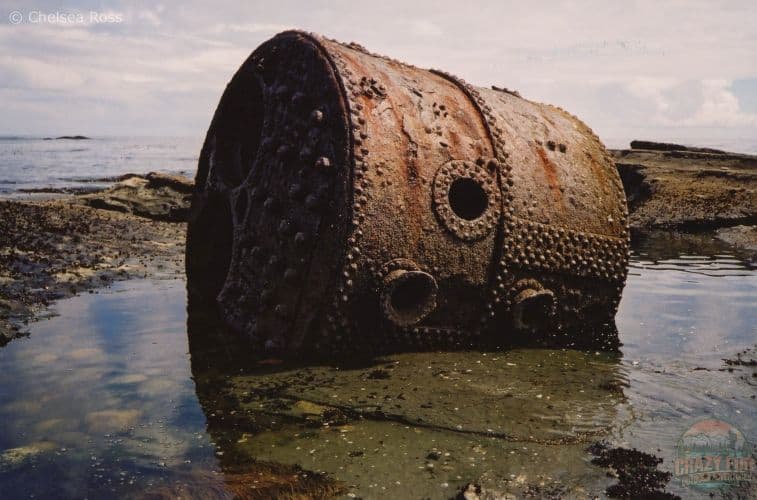
We found a huge boiler in the ocean.
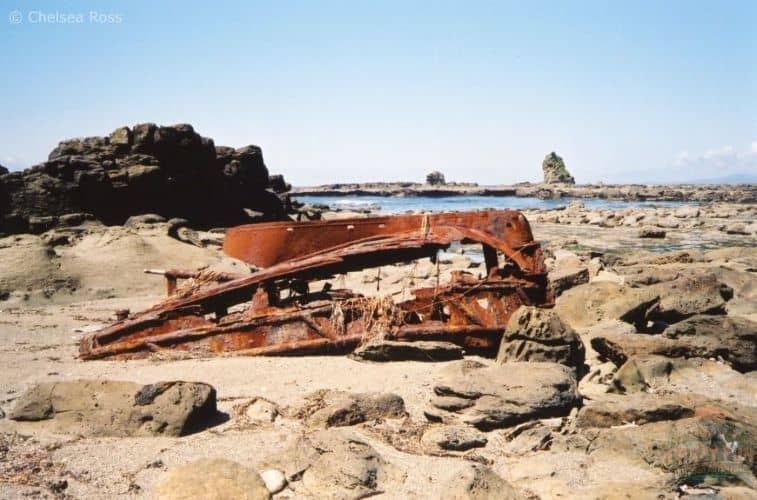
Various parts of ships can be found along the beach, including a barrel and a shipwreck.
It was fascinating to discover ship remnants left on the seabed over the years. Ships had collided with the west coast of Vancouver Island due to fog and distant lighthouses not shining strongly enough for them to see their path in the ocean.
8. Lighthouses: Backpacking the West Coast Trail
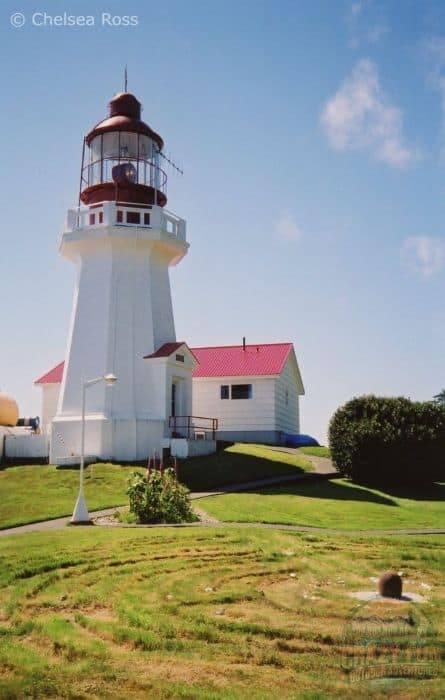
Carmanah Lighthouse Photo credit: Carole Ross
On Carmanah Point, you’ll find Carmanah Lighthouse, where two families lived in separate houses year-round at the time. This is the first lighthouse you’ll see travelling south to north on the trail.
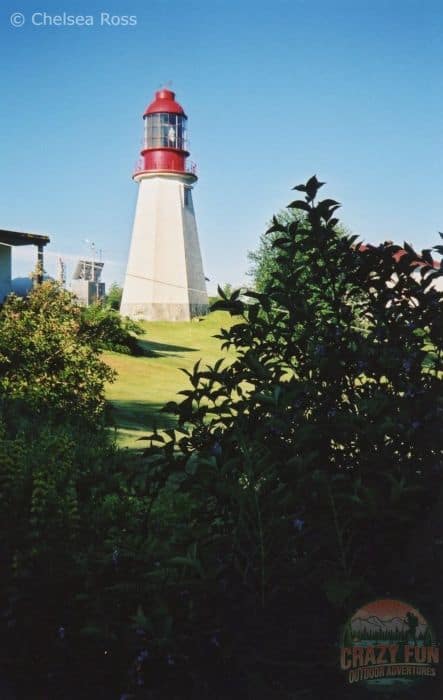
The second lighthouse, Pachena Point lighthouse, built in 1908, can also be found backpacking the West Coast Trail. It is considered one of the major coastal lights on the southwest coast of Vancouver Island. The eight-sided building is the last original wooden light tower on the West Coast of Canada.
9. Cable Cars

Throughout the trail, cable cars were used to cross creeks or rivers. Two people could fit in the middle, with their backpacks.
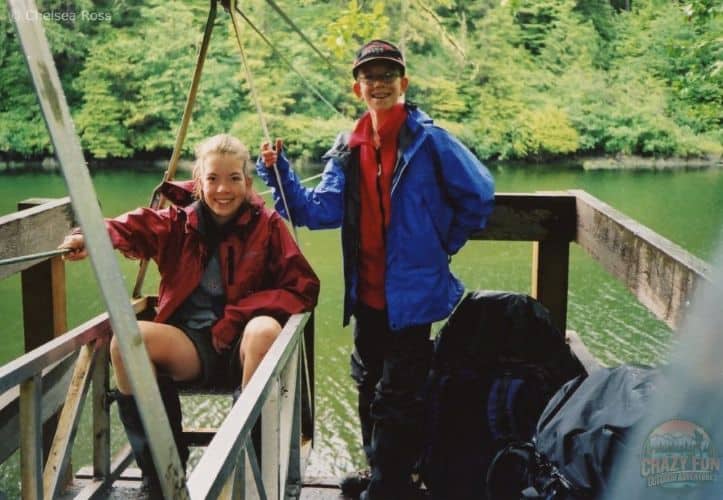
Some backpackers chose to wear light colours and ended up with rust-stained shirts by the end of the cable car crossing. Remember, it’s extremely wet backpacking the West Coast Trail.
West Coast Trail Tips
Tip #1: Rain on metal rusts; when the wheels turn, it sprays on you. It’s not a clean process. Expect to be dirty after the crossing.
Tip #2: If you have people at both ends, they can help pull you across, or you can get fellow backpackers to help you along. Hikers help each other out on the West Coast Trail. If others are close by, they’ll be happy to help you out, knowing they might appreciate assistance in the future. Otherwise, if no one can help, you’ll need strong muscles to pull your body weight across.
10. Two Boat Crossings
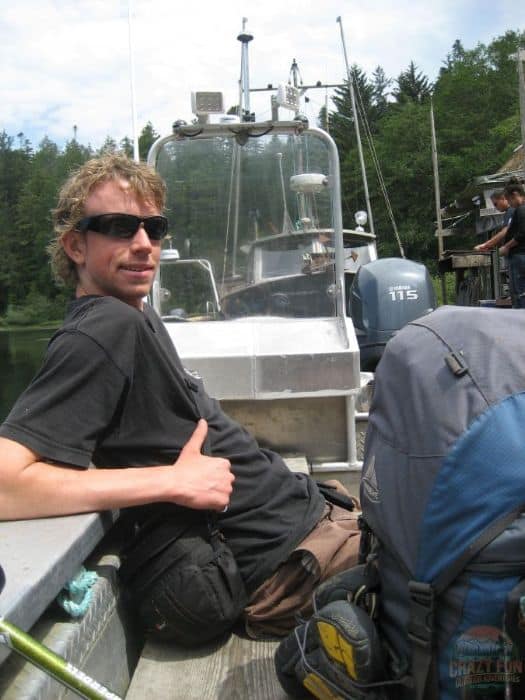
My brother is relaxing on a ferry crossing to Nitinaht Narrows.
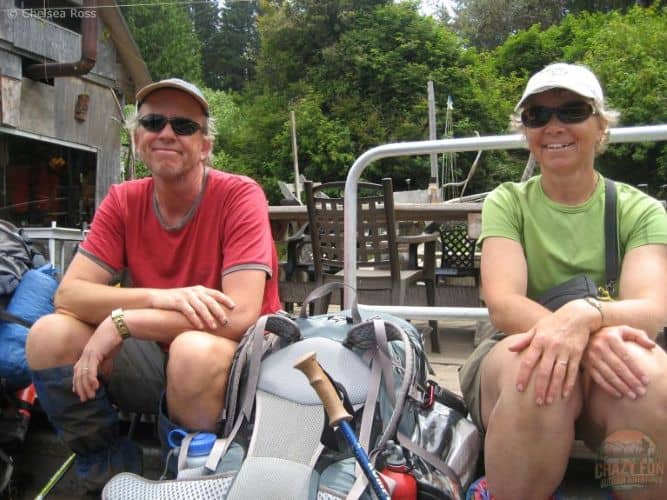
Two crossings (Gordon River and Nitinaht Narrows) must be traversed by ferry, run by the Ditidaht and Pacheedaht First Nations. If you’re going south to north, the first ferry crossing is a five-minute ride across the Gordon River to the West Coast Trail trailhead run by the local indigenous community. It costs $22/person to go across. Going from Cribs Creek to Tsusiat Falls, you’ll have to cross Nitinaht Narrows by ferry to get across Nitinaht Lake. The ride takes between twenty and thirty minutes. It also costs $22/person. It allows for a nice break to sit and relax.
Tip: When making the initial West Coast Trail reservation, the cost of both ferries is added to the total price.
11. Ladders Everywhere
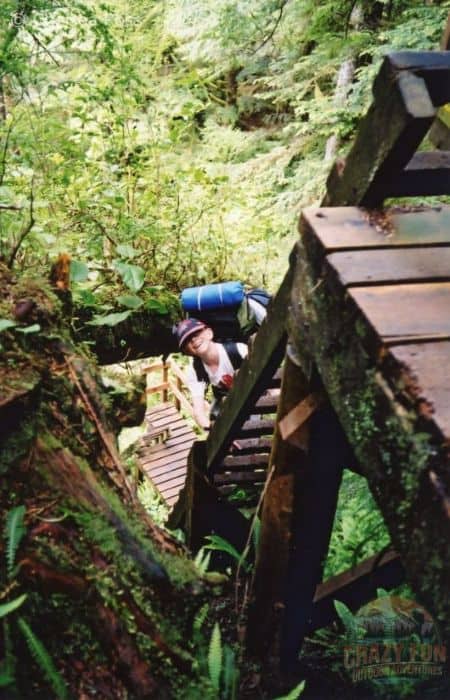
Ladders are everywhere along the trail. If you hike in the forest, you’ll require one when going down to cross a stream or a river and then back up on the other side.
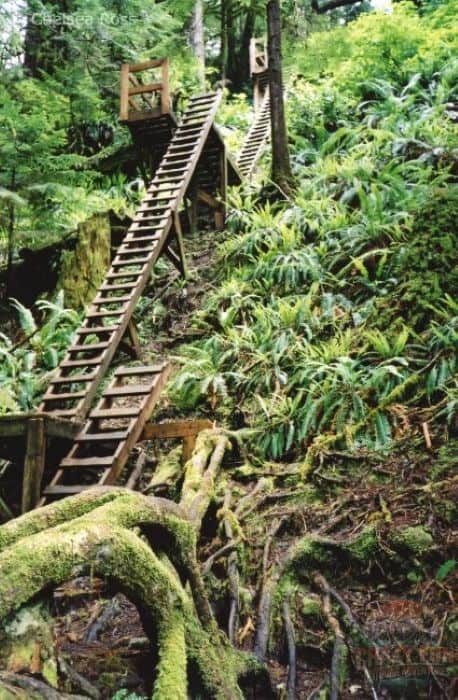
In one day, we counted five sets of ladders containing two hundred and fourteen steps!
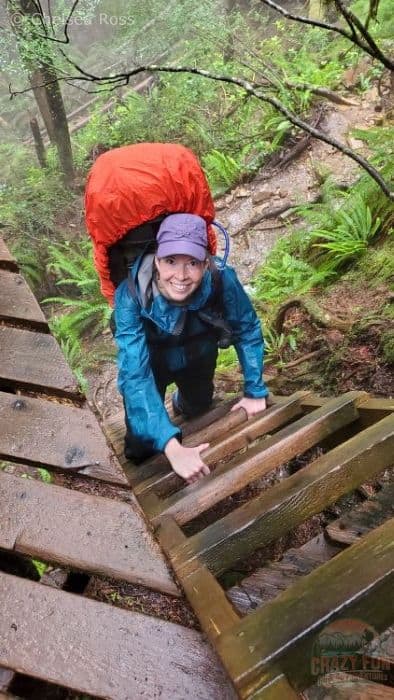
All the campsites are on the beach. If you want to walk on the seabed for your hike or set up camp, you must descend ladders to reach the beach and then climb back up the next morning.
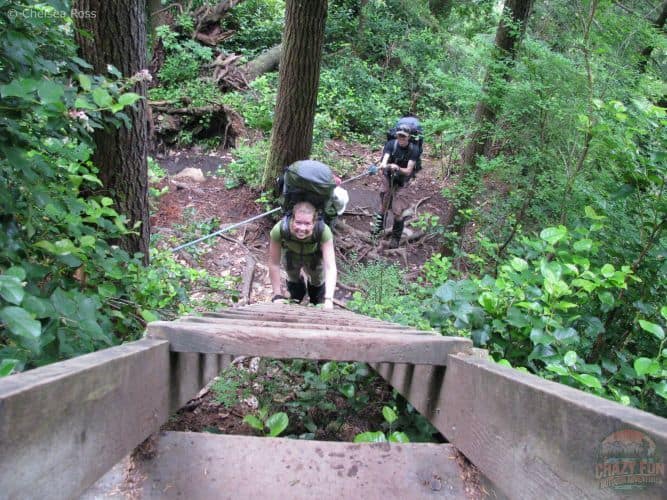
You’ll get lots of exercise to start and end your day.
Sometimes, you’ll need to climb and hike up using a rope.
12. Boardwalk Conditions Vary
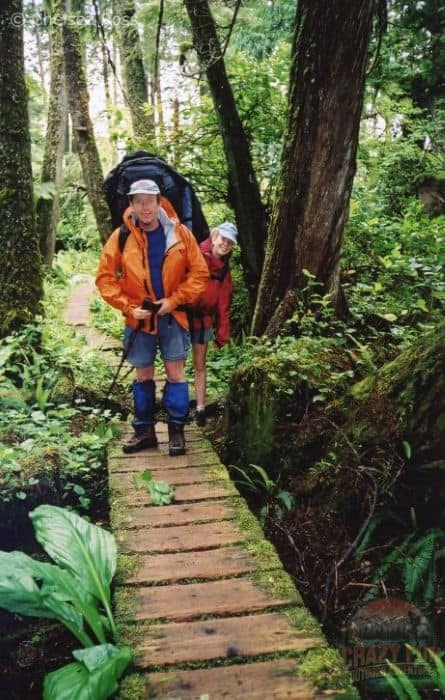
Ten years later, the trail seemed worse the second time, as steps were missing going up and down ladders. Parks Canada does its best to maintain the trails. They keep making repairs on an ongoing basis. With the wet weather the area receives, it’s hard to have the entire trail in perfect condition.
Slippery Boardwalks
We knew boardwalks got slippery. Poles gave us some stability. The West Coast Trail, though, is a different ball game. You’ll never see boardwalks as slick as you will there. My dad walked slowly and cautiously, as we heard stories about the slippery trail conditions. Before he knew it, he was flying off the boardwalk with his hiking boots and gear on his back. His glasses went flying, and by some miracle, he caught them in his hand in mid-air, before they could fall into the abyss. He was hanging onto the sloped boardwalk with his hands (this one hadn’t been repaired yet), and his feet were hanging off an extremely steep cliff.
It was like watching a Bugs Bunny cartoon show. It was so ridiculous that we thought it would never happen. But I assure you, it did. Since then, boardwalks have taken on a whole new meaning.
Make your best judgment and be cautious on the parts of the trail that haven’t been maintained recently.
13. Share the Load!
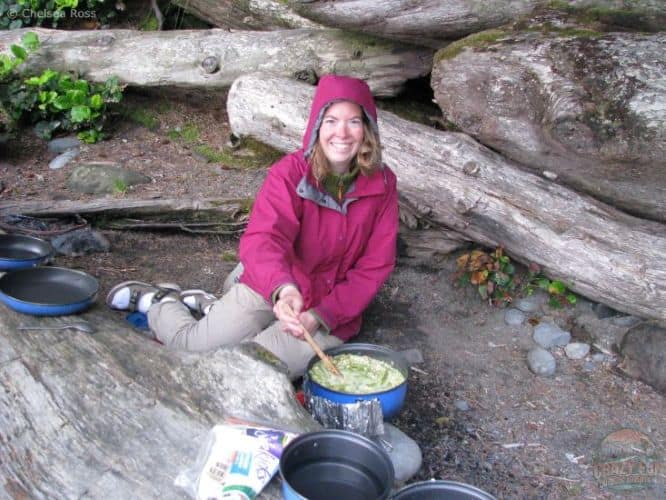
As a family of four, we were competing to quickly reduce the weight of our backpacks when it came to meals. We went for seven nights and had two suppers each to cook, with one extra, in case we ran into trouble. It was funny to see everyone offering to cook their meal early in the trek to alleviate the weight. We ate from West Coast Trail: Exciting Food. Some meals included one of the following: rice or noodles with dehydrated vegetables (corn, peas, carrots, green beans) and dehydrated meat (chicken, hamburger, pork). The rice packages come with spices already, making it nice and easy to cook with flavour. Two packages of rice with an assortment of veggies and meat will provide enough food for a family of four.
14. Boulders and Logs on the Beach
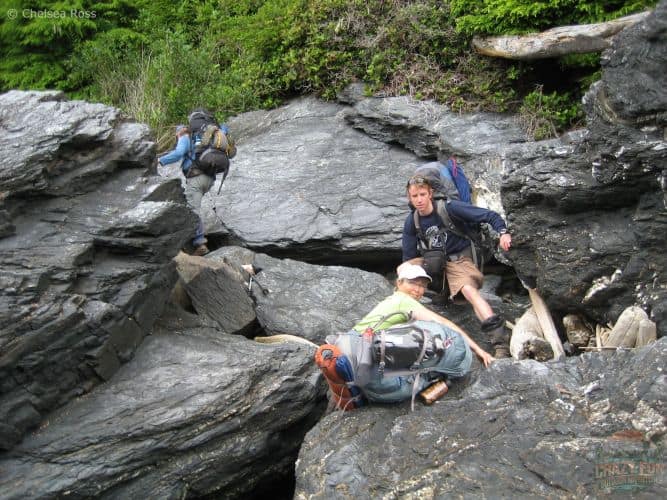
After the logs, mud bogs, and slippery roots, the pleasure continues by going over boulders and driftwood on the beach. Sometimes, they are so huge that you will need to remove your backpack. There are always new challenges around the corner. You’ll never be bored, that’s for sure!
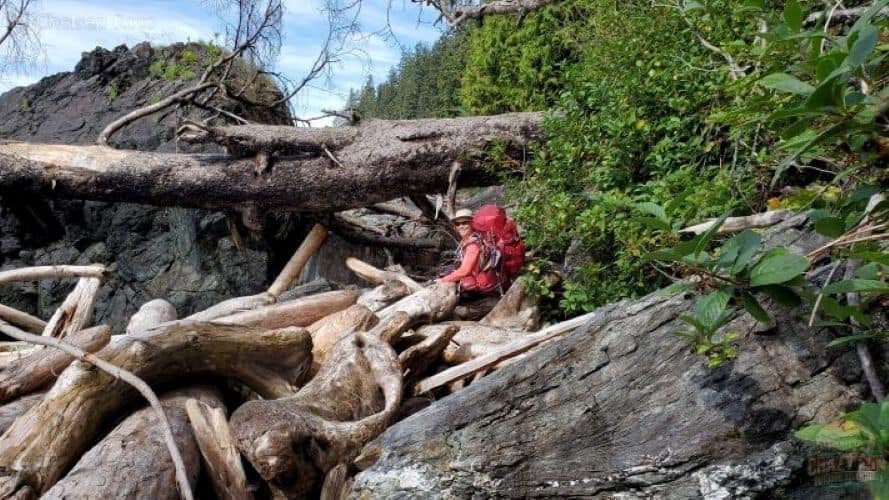
This was a regular sight on this section of the trail. There were many logs and massive boulders to navigate.

Photo credit: Carole Ross
Sometimes, we had narrow passageways that required us to get on our hands and knees.
15. Kilometre Markers
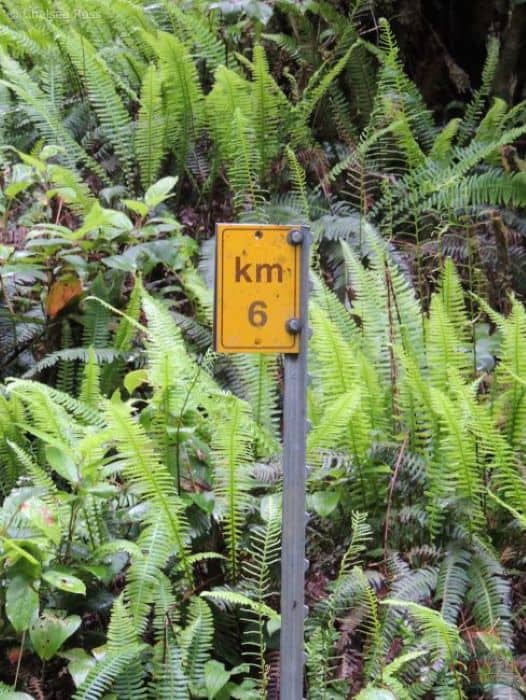
There are yellow kilometre markers along the way to help you plan and encourage you to keep going.
Tip: Knowing how far away you are from your campsite is also helpful. The signs stand out nicely against the green plants, trees, and moss in the background.
16. Eat Salmon at Nitinaht Narrows Boat Crossing

At Nitinaht Narrows, before crossing Nitinaht Lake by ferry, you can order fresh salmon, crab or lobster with a baked potato and a drink at the boat crossing. This is going from Cribs Creek to Tsusiat Falls or vice versa. It’s pricey but totally worth the delicious fresh meal caught earlier that day! Plus, you can sit and relax for a few minutes before continuing your journey. You’ll find a choice of pop, beer, and chips for additional treats to go with your meal, if you wish. They don’t take credit cards; make sure to bring some cash with you on the trail.
17. Scary Crossing
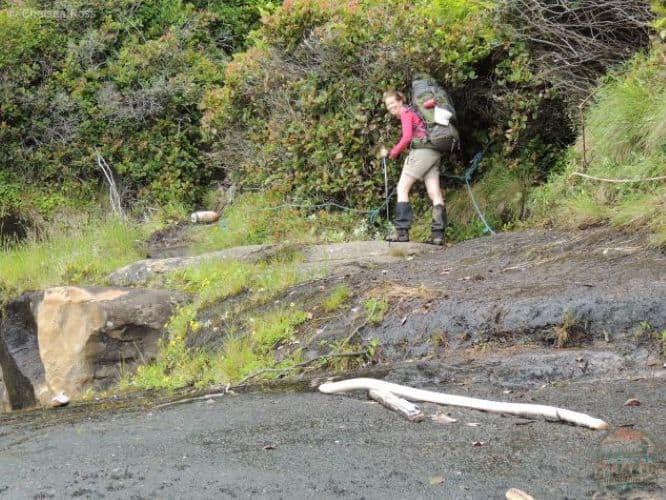
When choosing to hike along the beach, a scary crossing (captured by Scott Ross) over a surge channel requires you to grab onto a flimsy rope to guide you across, while stepping on algae with rushing water below you. If you slip, you could fall into the ocean and be swept away. Scary thought!
West Coast Trail Tips
Tip #1: It doesn’t feel scary when the conditions are dry (this was our second time backpacking the trail).
Tip #2: When the conditions are wet (the first and third time), it feels more nerve-wracking, even with the rope to help guide you across. Since it had been raining, the conditions were slippery, making it a huge factor in feeling uncomfortable crossing. Take your time, be patient, encourage each other, and you’ll be across in no time.
18. Walking on the Beach
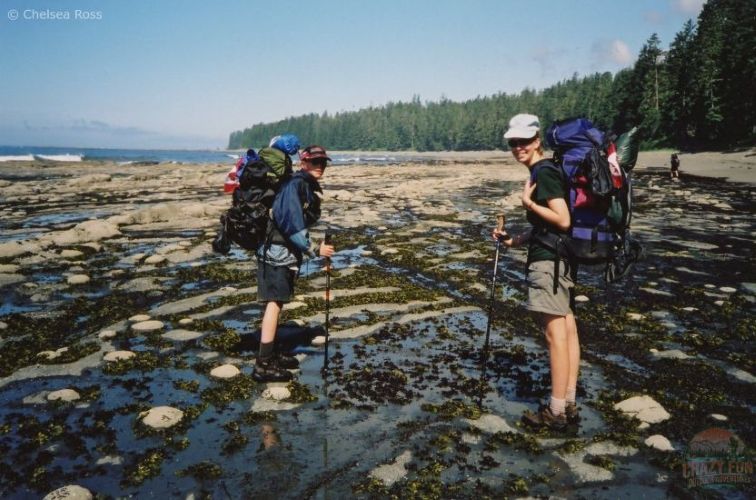
The first time we backpacked the West Coast Trail, we walked on the beach during Canada Day, proudly wearing our flags.
Watch your footing when walking near seashells and algae, as it can be slippery. Be cautious.
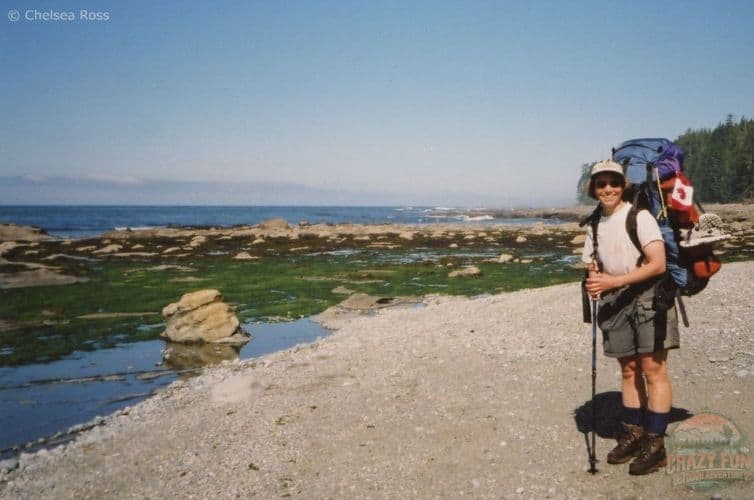
West Coast Trail tips: Hiking on the beach can seem simple, except that it might feel like walking one step forward and two steps back at times. Make sure to give yourself enough time. The length of the hike can be misleading.
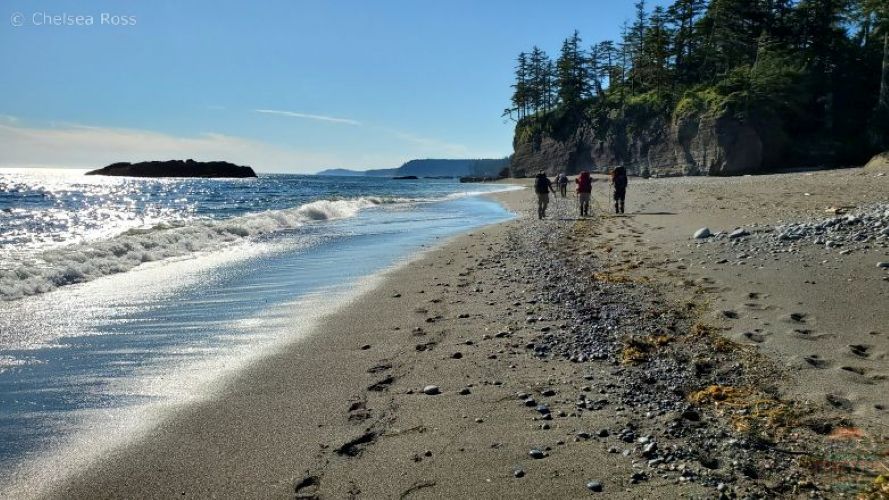
Walking on the beach can be pleasant, especially if you come from an enclosed forest and see everything around you, even if it’s foggy.
19. Gorgeous Sunny Days
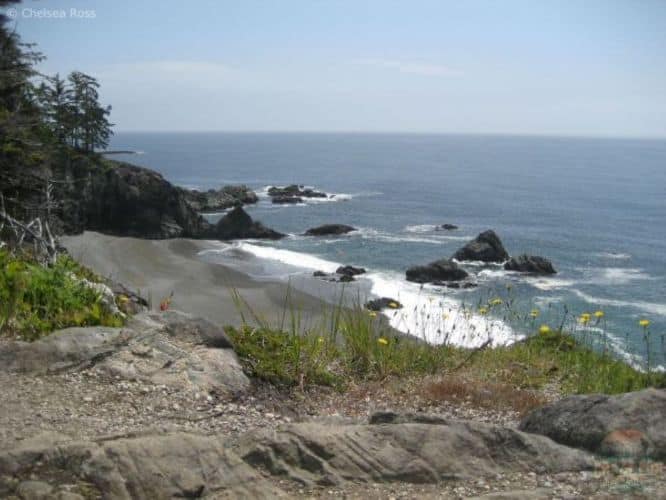
Once in a while, you can experience gorgeous sunny days!

These days are wonderful, especially when you can capture the hole-in-the-wall at Tsusiat Point.
20. River Crossings

Every once in a while, we had to cross rivers in knee-deep water.
West Coast Trial Tips
Tip #1: One option is to hold hands with a buddy as you walk across. Unbuckle your waist and chest belts in case you fall in the water. You don’t want to be carried to the ocean with the weight of your pack underwater, which could potentially cause you to drown. Wearing boots is optional. You get more stability if you wear them, but your boots are soaking wet for the rest of the day. I wore my hiking sandals to get more grip and have dry hiking boots for the rest of the day. A pole helps give you some stability in the water.
Tip #2: Use one or two poles to help you get across.
I should not have been wearing my boots around my neck, in case I fell and they strangled me. It’s best to tie them up somewhere on the backpack. I figured that it would be fine, with a relatively shallow crossing. Use your judgment.
21. Suspension Bridges

Many suspension bridges facilitate crossing creeks and rivers throughout the West Coast Trail. If you don’t like heights, like me, make sure no one else is behind you swinging on the bridge, as it can be scary. You might have to overcome this fear to complete the trail.
You’ll have to take turns on this bridge, as there isn’t enough space for two people crossing simultaneously.
The bridge offers gorgeous ocean views, though, to offer encouragement!
22. Setting up Camp on the Beach
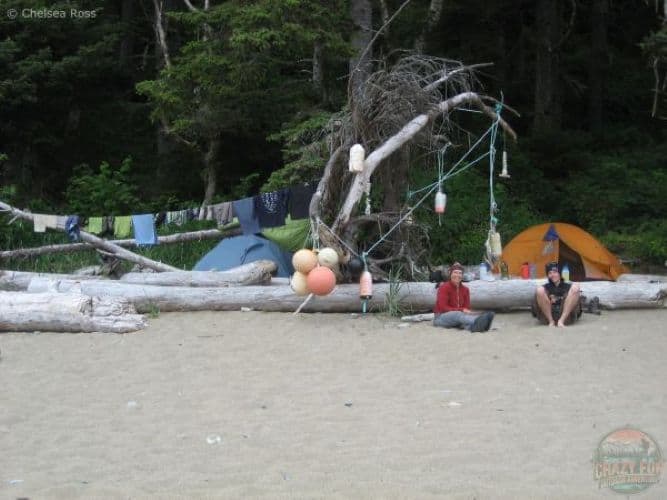
The nice part of being on the beach with driftwood surrounding your tent is that you can easily set up a clothesline to dry things after it’s raining. It allows a nice place to sit for good conversations or to relax and read a book.
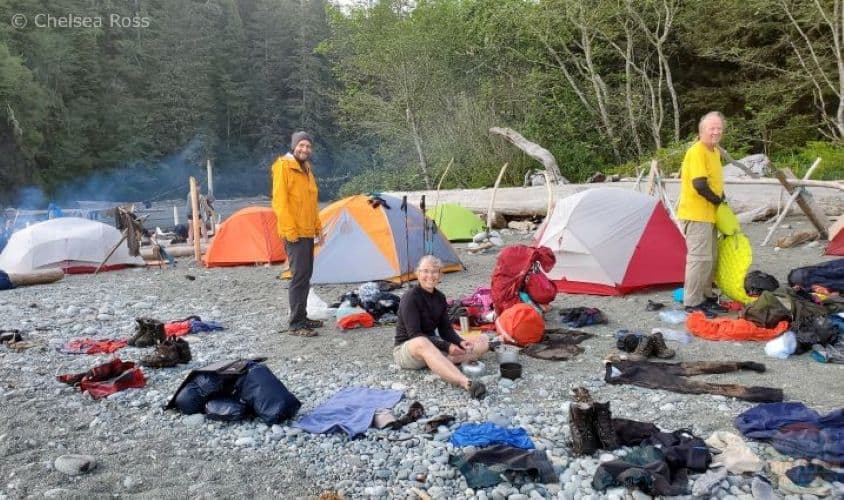
There isn’t a separate designated eating area on the West Coast Trail. We cooked and ate in the sand in front of and away from our tents. If you’re lucky, you might even see wildlife while eating your meal.
23. Exhaustion on the West Coast Trail!
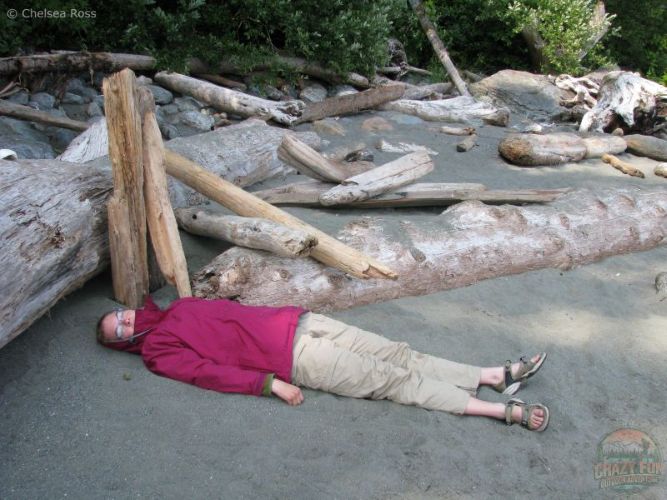
If you’re exhausted, you can rest your head and nap in the sand. Don’t underestimate how tired you’ll be each day’s end. It’s a gruelling trip that demands observation; constantly paying attention to the mud, roots, slippery logs and boardwalks, going up and down ladders, and walking on the beach. There are so many different components and technical skills required. It will be a much more enjoyable trip if you can keep calm, be patient, adapt and change your plans as situations arise. Allow yourself enough downtime at camp to set up, cook your meal, eat and enjoy the scenery while relaxing. One of the most valued parts of the trip is to experience it instead of speeding through the course.
24. Swimming at Tsusiat Falls
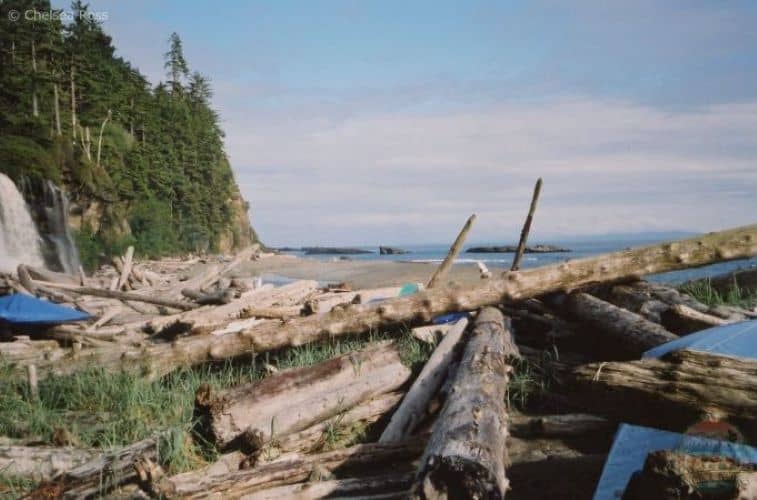
This was the gorgeous view of Tsusiat Falls from our tent.
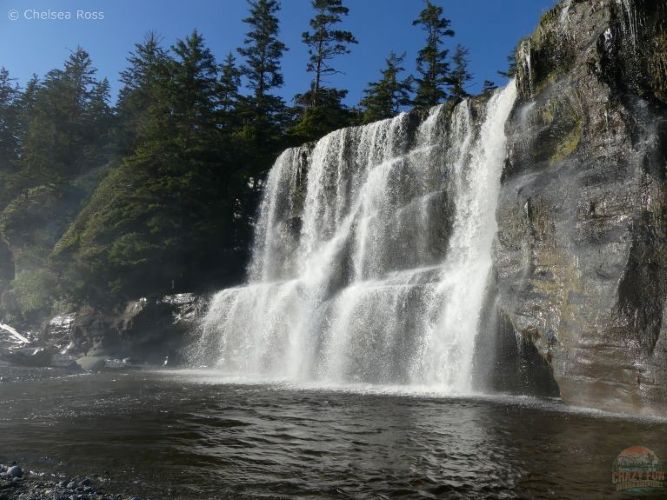
Photo credit: Carole Ross
West Coast Trial tips: Gorgeous water temperature for swimming. Nice to wash off all the grit and feel refreshed again.
25. Memorable Trip: Backpacking the West Coast Trail!
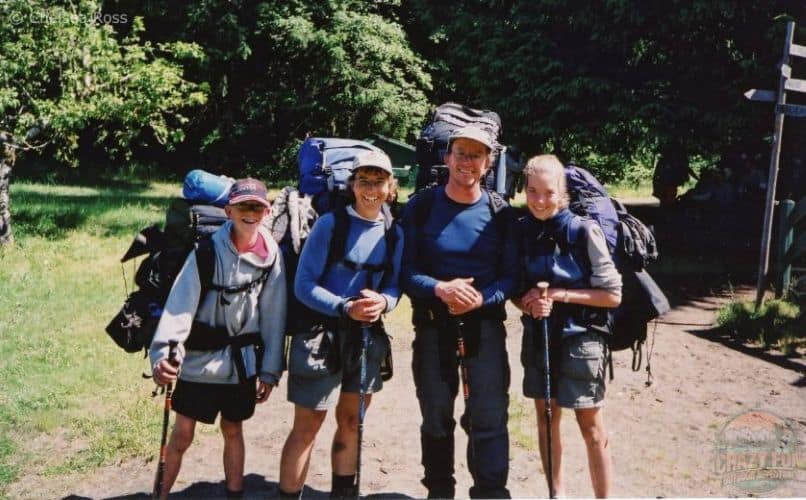
This was a family photo of the first time we completed the trail.

This was a family picture of the second time we completed the trail.
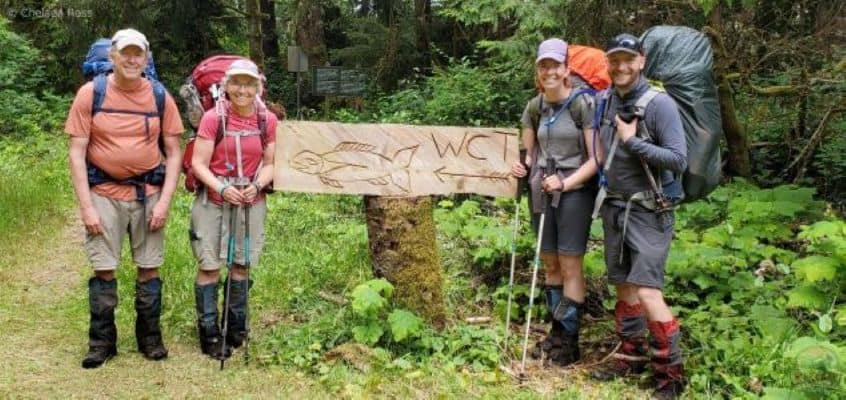
I am incredibly proud to have completed the West Coast Trail for a third time. What an enormous accomplishment! It is one of the most memorable trips you’ll ever take.
Every time my family and I take a trip together, our bond grows stronger and stronger. I feel there is enormous value in spending time doing outdoor adventures with family. They become your rock and people you can rely on, not only when doing your trips, but in your day-to-day life. You can learn so much from each other when you spend time together. One of our family routines, which we do at the end of every trip, is to congratulate each other with a family hug. It’s become one of those special traditions I look forward to when planning a trip. It’s important to build those routines early and give children and young adults something to look forward to every time.
My brother and I were strong hikers at both ages. We were competent. Your children can do it too. Presume Outdoor Competence in Kids and go backpacking with them at an early age to ensure they have enough backpacking experience before the West Coast Trail. You want to set them up for success, even though it is a challenging backpacking trip. With lots of backpacking practice, encouragement, courage, confidence, determination and passion from your family, you’ll also be successful backpacking the West Coast Trail!
Final Thoughts
Make sure to keep these West Coast Trail tips handy when planning your West Coast Trail backpacking trip. It’s difficult every time, but that’s why we do it. To overcome the challenges each time and brag that you’ve accomplished it another time! Get ready by Backpacking Poboktan Trail Successfully and do a trial run before this trip. You’ll be happy that you put the time and effort into training before this adventure. Here is a weight breakdown of each item Kris and I brought on the trip. We also describe items we could have eliminated from our pack after completing the trip. Check out the Ultimate WCT Packing List for more info.
Book your trip through this site to get started!
Additional Links
- Stay Positive Backpacking in the Rain
- Review: Sea to Summit X-Bowl
- Review: GSI Escape 2L Pot
- Hiking Near Nordegg: Where Should I Go?
- Where Can I Find Spectacular Waterton Fall Hikes?
Trip Resources
- Book your flights with Expedia
- Book your hostel through Hostelworld.com
- Book your hotel with Hotels.com
- Book your vacation rental with Vrbo
- Book Victoria: 3-Hour Zodiac Whale-Watching Tour
Pin It

This post may contain affiliate links. If you purchase through my links, I might receive a small commission, at no additional cost to you. I only recommend companies and products that I’ve used and tested myself. If you’d like to support me, I’d greatly appreciate it! It will help pay for the costs to run my website.

Super! Merci pour le partage! J ai vraiment aimé lire ton récit, tellement bien détaillé que ça donne un bon aperçu de ces aventures.
Tu y es allée à quelle période de l année?
T’es bienvenue Audrey! Merci de l’avoir lu! T’es gentille. Merci beaucoup! On est allés la fin juin la première fois et début juillet la deuxième fois. On a reçu beacoup de pluie la première fois et rien la deuxième fois. Je crois que juillet serait un meilleur temps, si tu veux l’essayer 🙂
Ok merci! J’imagine qu’il y a de la boue tout le temps alors. Je ne savais pas du tout.
Oui, beaucoup de boue tout le temps, malheureusement. Mais, ça l’ajoute du charactère au sentier. C’est un bon challenge mais tu vas être fière de toi-même une fois que tu l’as fini 🙂